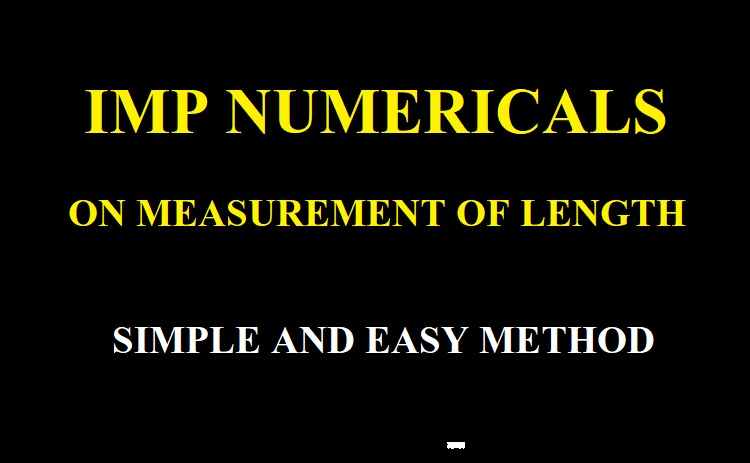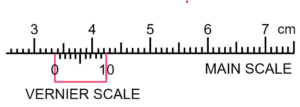Measurements and Experimentation Exe-1B Measurement of Length Numericals for ICSE Physics Class-9 Selina Publishers Solutions Chapter-1. There is the solutions of short Answer type Questions of your latest textbook which is applicable in 2023-24 academic session. Visit official Website CISCE for detail information about ICSE Board Class-9
Measurements and Experimentation Exe-1B Measurement of Length
Numericals Questions for ICSE Class-9 Physics Selina Concise Solutions of Ch-1
| Board | ICSE |
| Class | 9 |
| Subject | Physics |
| Writer / Publication | Concise selina Publishers |
| Chapter-1 | Measurements and Experimentation |
| Exe – 1 B | Measurement of Length |
| Topics | Solution of Numericals |
| Academic Session | 2023-2024 |

Measurement of Length Exe-1(B) Numericals
Ch-1 Measurements and Experimentation ICSE Class-9 Concise Physics Selina Solutions
Page 22
Question 1. A stopwatch has 10 divisions graduated between the 0 and 5 s marks. What is its least count?
Answer :
Range of the stop watch = 5s
Total number of divisions = 10
L.C. = 5/10
= 0.5 s
Question 2. A vernier has 10 divisions and they are equal to 9 divisions of the main scale in length. If the main scale is calibrated in mm, what is its least count?
Answer : Value of 1 m.s.d. = 1 mm
10 vernier divisions = 9 m.s.d.
L.C. = Value of 1 m.s.d./number of divisions on vernier scale
= 1 mm/10
= 0.1 mm or 0.01 cm
Question 3. A microscope is provided with a main scale graduated with 20 divisions in 1 cm and a vernier scale with 50 division on it of length same as of 49 divisions of main scale. Find the least count of the microscope.
Answer : 1 main scale division = 1/20 cm
1 division of vernier scale = 49 50 main scale divisions
= 0.98 main scale division
Vernier calipers:
L.C. = I main scale division – I vernier scale division
= I main scale division – 0.98 main scale division
= 0.02 main scale division
Microscope:
1 main scale division = 1/20 cm
L.C = 0.02 1/20
Least count of the microscope is
Thus, the least count of the microscope is 0.001 cm.
Question 4. A boy uses a vernier callipers to measure the thickness of his pencil. He measures it to be 1.4 mm. If the zero error of vernier callipers is +0.02 cm, what is the correct thickness of the pencil?
Answer : Thickness of the pencil (observed reading) = 1.4 mm
Zero error = + 0.02 cm = + 0.2 mm
Correct reading = observed reading – zero error (with sign)
= 1.4 mm – 0.2 mm
= 1.2 mm
Question 5. A vernier callipers has its main scale graduated in mm and 10 divisions on its vernier scale are equal in length to 9 mm. When the two jaws are in contact, the zero of the vernier scale is ahead of the zero of the main scale and the 3rd division of the vernier scale coincides with a main scale division.
Find :
(i) The least count and
(ii) The zero error of the vernier callipers.
Answer :
(i) Value of 1 m.s.d. =1 mm
10 vernier divisions = 9 m.s.d.
L.C. = Value of 1 m.s.d./number of divisions on the vernier scale
= 1 mm/10
= 0.1 mm or 0.01 cm
(ii) On bringing the jaws together, the zero of the vernier scale is ahead of zero of the main scale, the error is positive.
3rd vernier division coincides with a main scale division.
Total no. of vernier divisions = 10
Zero error = +3 × L.C.
= +3 × 0.01 cm
= +0.03 cm
Question 6. The main scale of a vernier callipers is calibrated in mm and 19 divisions of main scale are equal in length to 20 divisions of the vernier scale. In measuring the diameter of a cylinder by this instrument, the main scale reads 35 divisions and 4th division of vernier scale coincides with a main scale division.
Find:
(i) Least count and (ii) Radius of a cylinder.
Answer :
(i) Value of 1 m.s.d = 1 mm = 0.1 cm
20 vernier divisions = 19 m.s.d.
L.C. = Value of 1 m.s.d./number of divisions on the vernier scale
= 1mm/20
and = (0.1/20) cm
hence = 0.005 cm
(ii) Main scale reading = 35 mm = 3.5 cm
Since 4th division of the main scale coincides with the main scale, i.e. p = 4.
Therefore, the vernier scale reading = 4 × 0.005 cm = 0.02 cm
Total reading = Main scale reading + vernier scale reading
= (3.5 + 0.02) cm
= 3.52 cm
Radius of the cylinder = Diameter (Total reading) / 2
= (3.52/2) cm
= 1.76 cm
Question 7. In the vernier callipers, there are 10 divisions on the vernier scale and 1 cm on the main scale is divided into 10 parts. While measuring the length, the zero of the vernier lies just ahead of the 1.8 cm mark and the 4th division of vernier coincides with a main scale division.
(a) Find the length.
(b) If zero error of vernier callipers is -0.02 cm,
What is the correct length ?
Answer :
(a) L.C. of vernier callipers = 0.01 cm
Main scale reading = 1.8 cm
Since 4th division of the main scale coincides with the main scale, i.e. p = 4.
Therefore, the vernier scale reading = 4 × 0.01 cm = 0.04 cm
Total reading = Main scale reading + vernier scale reading
= (1.8 + 0.04) cm
= 1.84 cm
(b) Observed reading = 1.84 cm
Zero error = -0.02 cm
Correct reading = Observed reading – Zero error (with sign)
= [1.84 – (-0.02)] cm
= 1.86 cm
Exe-1(B) Numericals
Measurements and Experimentation for ICSE Class-9 Physics Selina Solutions
Page 23
Question 8. While measuring the length of a rod with a vernier callipers, Fig. 1.14 shows the position of its scales. What is the length of the rod?

Answer :
L.C. of vernier callipers = 0.01 cm
In the shown scale,
Main scale reading = 3.3 mm
6th vernier division coincides with an m.s.d.
Therefore, vernier scale reading = 6 × 0.01 cm = 0.06 cm
Total reading = m.s.r. + v.s.r.
= 3.3 + 0.06
= 3.36 cm
Question 9. The pitch of a screw gauge is 0.5mm and the head scale is divided in 100 part what is the least count of screw gauge.
Answer 9
Least count= Pitch/ Number of division
= 0.5/100 = 0.005 mm = 0.0005 cm
Question 10. The thimble of a screw gauge has 50 divisions. The spindle advances 1 mm when the screw is turned through two revolutions.
(i) What is the pitch of the screw gauge?
(ii) What is the least count of the screw gauge?
Answer :
No. of divisions on the circular scale = 50
(i) Pitch = Distance moved ahead in one revolution
= 1 mm/2 = 0.5 mm
(ii) L.C. = Pitch/No. of divisions on the circular head
= (0.5/50) mm
= 0.01 mm
Question 11. The pitch of a screw gauge is 1 mm and the circular scale has 100 divisions. In measurement of the diameter of a wire, the main scale reads 2 mm and 45th mark on the circular scale coincides with the base line. Find
(i) The least count and
(ii) The diameter of the wire.
Answer :
Pitch of the screw gauge = 1mm
No. of divisions on the circular scale = 100
(i) L.C. = Pitch/No. of divisions on the circular head
= (1/100) mm
= 0.01 mm or 0.001 cm
(ii) Main scale reading = 2mm = 0.2 cm
No. of division of circular head in line with the base line (p) = 45
Circular scale reading = (p) × L.C.
= 45 x 0.001 cm
= 0.045 cm
Total reading = M.s.r. + circular scale reading
= (0.2 + 0.045) cm
= 0.245 cm
Question 12. When a screw gauge with a least count of 0.01 mm is used to measure the diameter of a wire, the reading on the sleeve is found to be 1 mm and the reading on the thimble is found to be 27 divisions.
(i) What is the diameter of the wire in cm?
(ii) If the zero error is +0.005 cm, what is the correct diameter?
Answer :
(i) L.C. of screw gauge = 0.01 mm or 0.001 cm
Main scale reading = 1 mm or 0.1 cm
No. of division of circular head in line with the base line (p) = 27
Circular scale reading = (p) × L.C.
= 27 × 0.001 cm
= 0.027 cm
Diameter (Total reading) = M.s.r. + circular scale reading
= (0.1 + 0.027) cm
= 0.127 cm
(ii) Zero error = 0.005 cm
Correct reading = Observed reading – zero error (with sign)
= [0.127 – (+0.005)] cm
= 0.122 cm
Question 13. A screw gauge has 50 divisions on its circular scale and its screw moves by 1 mm on turning it by two revolutions. When the flat end of the screw is in contact with the stud, the zero of the circular scale lies below the base line and 4th division of the circular scale is in line with the base line. Find
(i) The pitch,
(ii) The least count and
(iii) The zero error of the screw gauge
Answer :
No. of divisions on the circular scale = 50
(i) Pitch = Distance moved ahead in one revolution
= 1 mm/2 = 0.5 mm
(ii) L.C. = Pitch/No. of divisions on the circular head
= (0.5/50) mm
= 0.01 mm
(iii) Because the zero of the circular scale lies below the base line, when the flat end of the screw is in contact with the stud, the error is positive.
No. of circular division coinciding with m.s.d. = 4
Zero error = + (4 × L.C.)
= + (4 × 0.01) mm
= + 0.04 mm
Question 14. Fig 1.15 below shows the reading obtained while measuring the diameter of a wire with a screw gauge. The screw advances by 1 division on the main scale when circular head is rotated once.

Find: (i) Pitch of the screw gauge,
(ii) Least count of the screw gauge and
(iii) The diameter of the wire.
Answer :
No. of divisions on the circular scale = 50
(i) Pitch = Distance moved ahead in one revolution
= 1 mm/1 = 1 mm.
(ii) L.C. = Pitch/No. of divisions on the circular head
= (1/50) mm
= 0.02 mm
(iii) Main scale reading = 4 mm
No. of circular division coinciding with m.s.d. (p) = 47
Circular scale reading = p × L.C.
= (47 × 0.02) mm
= 0.94 mm
Diameter (Total reading) = M.s.r. + circular scale reading
= (4 + 0.94) mm
= 4.94 mm
Question 15. A screw has a pitch equal to 0.5 mm. What should be the number of divisions on its head in order to read correctly up to 0.001 mm with its help?
Answer :
Pitch of the screw gauge = 0.5 mm
L.C. of the screw gauge = 0.001 mm
No. of divisions on circular scale = Pitch / L.C.
= 0.5 / 0.001
= 500
— : End of Measurements and Experimentation Exe-1B Numericals for ICSE Physics Class-9 Selina Solutions :–
Return to — Concise Selina Physics ICSE Class-9 Solutions
Thanks
Please share with your friends


